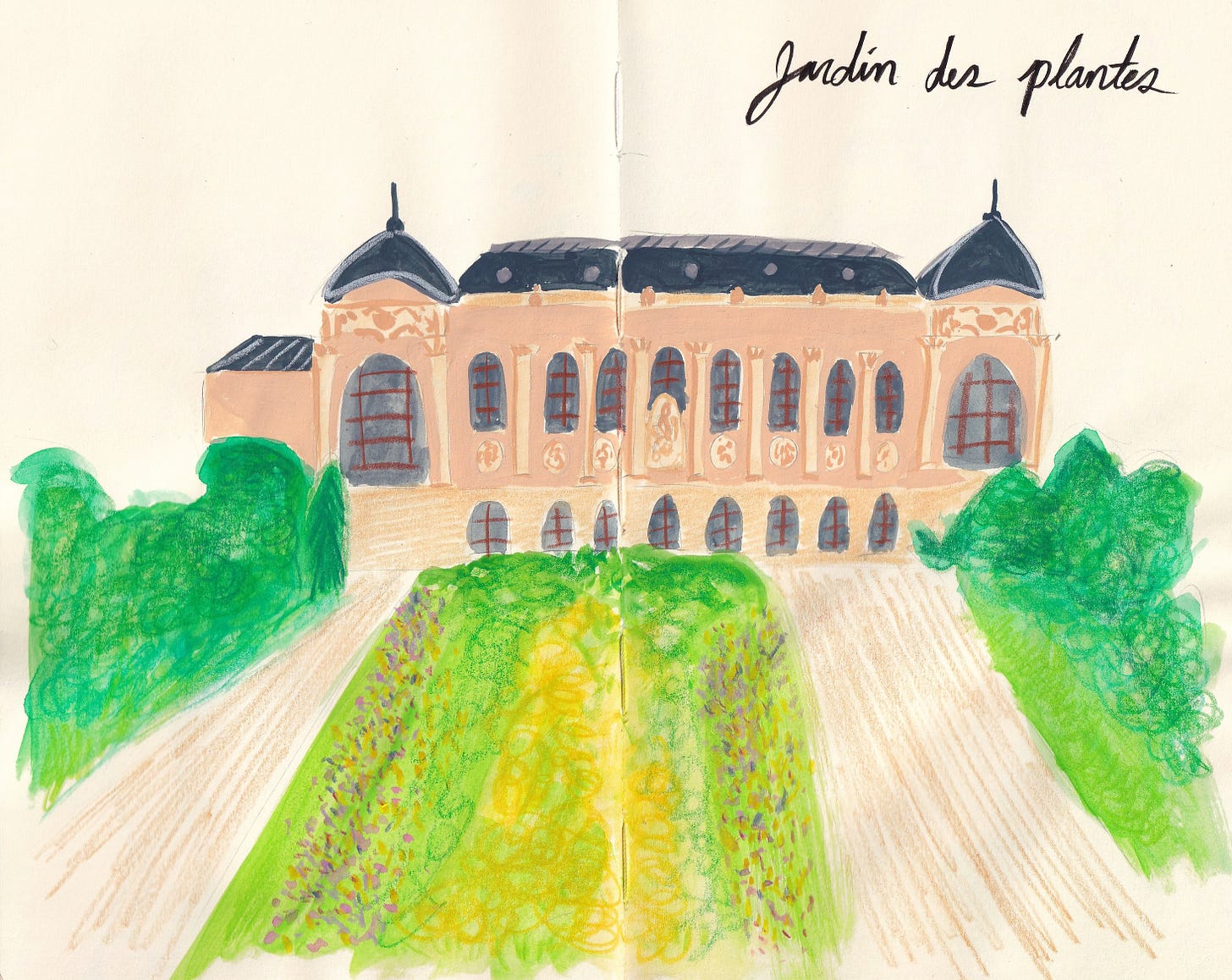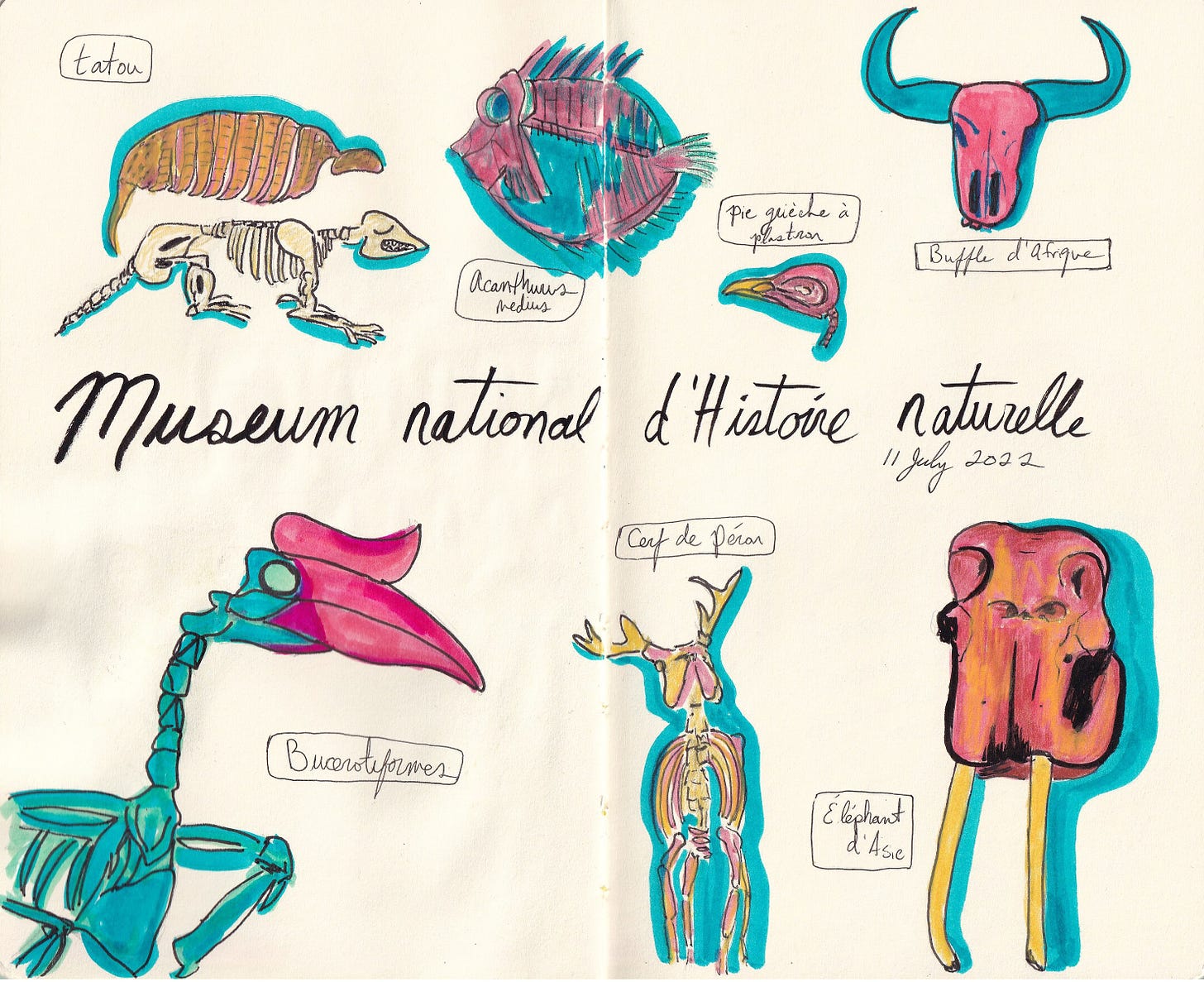Bonjour! Bienvenue to the first Paris Palette newsletter, a collection of what I hope will become more than just a glimpse of historic places in Paris and beyond. Each month I plan to tackle one theme, usually a building in Paris, and uncover the history of that place. And because I love to illustrate as much as I love to write, I plan to accompany these historical musings with drawings.
These illustrations will be interpretations and they’ll be raw. You’ll get a glimpse at my sketchbook, a look at how I see the world. Through these illustrations, I hope to convey the essence and story of the place, more so than worrying about how accurate the dimensions are. So while there might be four floors, I may only draw three. Let’s call it artistic liberty.
I will however endeavour to be as accurate as possible in my research, finding original sources (as far as my limited French can take me), and being clear about what might be unknown or disputed, while hopefully not being too long.
So without further ado, let’s begin our Paris tour with one of my favorite places to spend a sunny day in the city… Les Jardin des Plantes de Paris.
In the early 1600s, Paris was small, dark, and overcrowded. You could walk from the north to the south in just half an hour. Officials estimate the population was 415,000 in 1637, making it one of the largest cities in the world at the time.
It was also a very prosperous city. Some of the most famous parks and monuments were built or expanded on, such as the Louvre and Tuileries Palace, Pont Neuf, and Luxembourg Garden. Many of these expansions were to highlight the power of the king and the French monarchy.
Which is perhaps why one cold and probably grey day in January 1626, Louis XII established a royal medicinal garden outside the walls of the city, so that “the vapors of cesspools and the fumes of chimneys do not steal the dew of the plants.” 1
Originally only meant to be for the king and nobility, the garden was opened to the public in 1640.
But it wasn’t until 1739 that the jardin became one of the biggest contributions to science in Europe.
Under the guidance of the naturalist Georges-Louis Leclerc, Comte de Buffon (who was in charge of the gardens and buildings from 1739-1788), the jardin became a scientific establishment, with one of the richest collections of the natural world at that time. This was largely due to exchanges, purchases, and collections carried out by French naturalists. At the time it was known as the Jardin du Roi (King’s Garden).
Buffon also made a number of contributions to the science world, namely his work as a naturalist. In fact, his discovery that different species could be crossbred but the offspring were infertile, contributed to the theory of evolution. Although at the time, he rejected the concept of evolution and instead believed in devolution, that animals decline from their original perfect state.
And then the Revolution happened.
I won’t go into the history of the French Revolution (I studied it for a year in school and I still don’t know all the details). But as a result of the overthrow of the monarchy, the Jardin des Plantes became home to the Natural History Museum on June 17, 1793, just a year after the royal menagerie was moved there from Versailles.
The zoo remains today and is one of the oldest zoos in the world (that title belongs to the zoo in Vienna). The zoo has had transformations since then, with multiple buildings throughout the years to accommodate various animals.
The buildings themselves are impressive and all are protected by conservation orders due to their unique architectural features. The first were small log cabins made of cob and thatch and were later extended into buildings of stone and metal. The styles of each vary according to when it was built. The Rotunda, for example, was built in the early 1800s and is in the shape of the Légion d'Honneur cross, while the monkey and big cat house are built in the characteristic Art Deco style of the 1920s and 30s.
The rest of the garden was also expanded in the 1800s, with the Galerie de Minéralogie et de Géologie and the Galerie de Zoologie to house Frances’ extensive and growing zoological collection, along with the Grande Galerie de L’évolution.
The latter is perhaps one of the most famous buildings in the gardens, after being closed for 30 years to undergo extensive renovations due to damage created during WWII. It reopened in 1994.

Today, the Jardin des Plantes includes 68 acres with over 23,500 plant species, six greenhouses for display and 22 used to cultivate plants, with a herbarium of over six million dried references, a botanical library, a zoo, a labyrinth, as well as three museums dedicated to the natural world.
For those who want to visit, the garden itself is free to wander around, while the zoo, Gallery of Evolution, the Paleontology Gallery, Geology and Mineralogy Gallery, and Greenhouses cost €7 to €13 each to enter.
Merci beaucoup for reading this far! I hope you learned a bit about Paris. If you have any comments or would like me to tackle another building in Paris, please let me know!
À bientôt,
-Moriah
Translated from Atlas de Paris: Évolution d’un Pasayage Urbain by Danielle Chadych and Dominique Leborgne.







I live nearby and go to the jardin to run and draw, and occasionally with the kids on the weekend. I had no idea about the history! Thanks so much for your research! They also just opened the Jardin des Plantes Vivaces, right next to the carousel. It's a small enclosed area that's overflowing with flowers and you can get very close to them (unlike in the main strip) – excellent for overthinking the details of every single bloom lol
Thank you, Moriah! Your writing and art makes me want to discover this wonderful place!